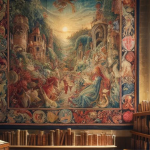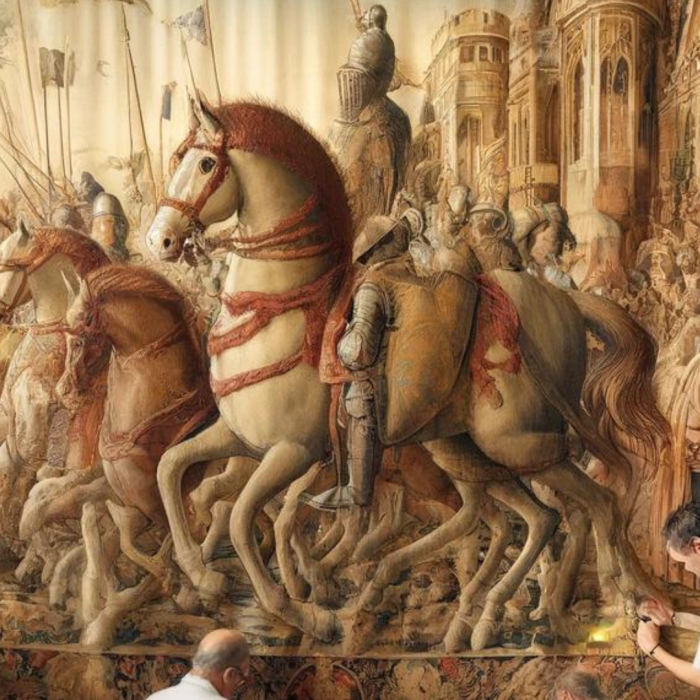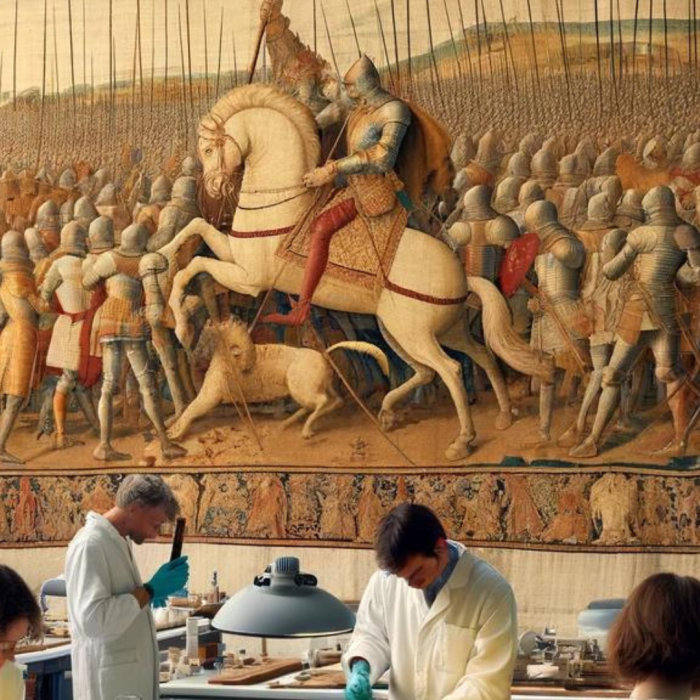The Process of Tapestry Restoration
Brief Explanation of Tapestry Restoration as an Art Form
Tapestry, a form of textile art traditionally woven by hand on a loom, is as captivating today as it was centuries ago. Unlike simple cloth, tapestries are distinguished by their complex designs and pictorial narratives, often using thousands of threads to create scenes teeming with detail and color. Historically, tapestries have been more than mere decorations; they were symbols of prestige and power, depicting legendary tales, historical events, and natural sceneries. From the intricate Bayeux Tapestry, which narrates the Norman Conquest of England in 1066, to the vibrant works of the Renaissance and beyond, tapestries have been a cornerstone of cultural heritage across civilizations.
The historical significance of tapestry cannot be overstated. In the halls of medieval castles and the walls of churches, tapestries served not only as insulators against the cold but also as movable frescoes that illustrated the values, myths, and ethos of the society. They were the medium through which artists expressed creativity, rulers showcased authority, and civilizations relayed their stories to future generations.
Yet, the very fabric of these historical artifacts is under constant threat from the ravages of time, light exposure, humidity, and pollution. Tapestry restoration, a delicate and intricate process, has thus become an indispensable practice in the preservation of our cultural heritage. It is a discipline that requires a deep understanding of historical techniques, patience, and a meticulous hand to reverse centuries of damage and wear. Through restoration, we not only safeguard these treasures for future enjoyment but also continue the tradition of storytelling and cultural reflection that is woven into the very threads of tapestries.
As we delve into the process of tapestry restoration, it’s crucial to appreciate the artistry and historical importance of these textiles. Understanding the significance of what is being preserved helps underscore the dedication and skill involved in restoration work. The following sections will explore the meticulous steps taken by conservators to breathe new life into these emblematic works of art, ensuring they continue to tell their stories for years to come.
This introduction serves as the gateway to the complex, rewarding world of tapestry restoration, inviting readers to appreciate the intricate blend of history, art, and science that this process entails.
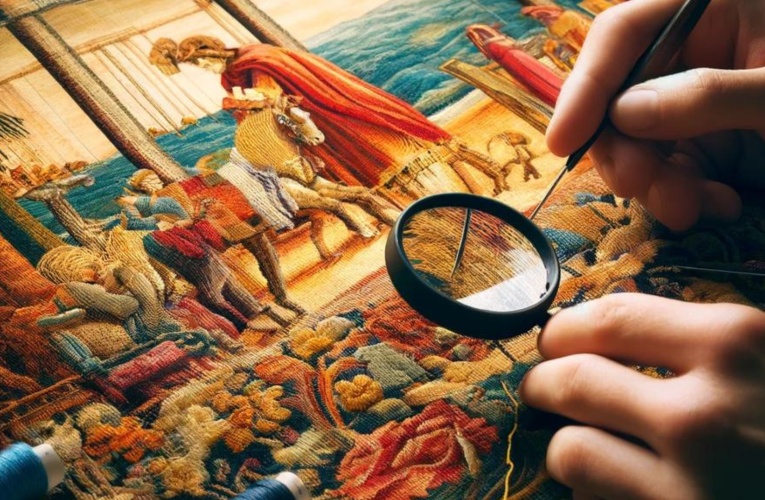
Understanding Tapestries
When considering the intricate and fascinating world of tapestry restoration, it’s vital to begin with a foundational understanding of tapestries themselves. This knowledge not only enhances our appreciation for these historic and artistic pieces but also sheds light on the challenges and techniques involved in their restoration. In this section, we’ll delve into the materials commonly used in tapestries, the different types of tapestries, and common issues leading to their degradation.
Materials Commonly Used in Tapestries
Tapestries are renowned for their vibrant colors, intricate designs, and the materials that bring these visual narratives to life. The choice of material not only contributes to the tapestry’s aesthetic appeal but also its durability and texture.
- Wool: Wool is a staple fiber in tapestry weaving, prized for its availability, versatility, and the richness of color it can hold. Woolen threads provide a sturdy base for tapestries, making them durable over centuries.
- Silk: Silk threads are used to add luster, depth, and fine detail to tapestries. Silk, often reserved for the most luxurious pieces, allows for a broader range of colors and a finer weave, creating intricate and vivid imagery.
- Gold and Silver Threads: The use of gold and silver threads elevates tapestries to objects of immense value and splendor. These metals are typically spun around a silk core and woven into the fabric to create shimmering effects and highlight important elements within the design.
Different Types of Tapestries
The technique used in creating a tapestry significantly impacts its texture, appearance, and the level of detail achievable in the design.
- Hand-Woven Tapestries: These are created on a loom, with artisans meticulously weaving threads by hand to form the tapestry’s design. This traditional method allows for a high degree of detail and uniqueness, with each piece reflecting the weaver’s skill and creativity.
- Machine-Made Tapestries: With the advent of industrialization, machine weaving became a method for producing tapestries more quickly and in larger quantities. While machine-made tapestries can replicate intricate designs at a faster rate, they often lack the distinctive characteristics of hand-woven pieces.
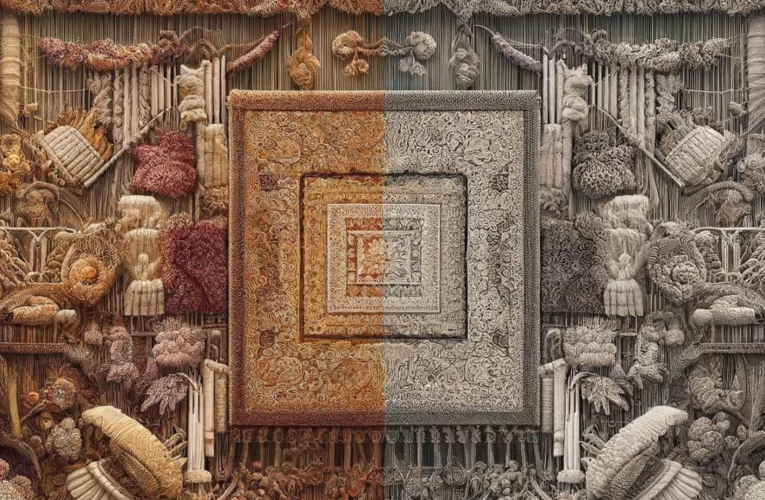
Common Issues That Lead to Tapestry Degradation
Tapestries, like all artifacts, are susceptible to various forms of degradation over time. Understanding these issues is crucial for effective restoration and preservation efforts.
- Fading: Prolonged exposure to light, especially sunlight, can cause the vibrant colors of a tapestry to fade, diminishing its visual impact and historical accuracy.
- Tears and Structural Damage: Physical stress, improper handling, or the natural weakening of fibers over time can lead to tears and other structural damage, compromising the tapestry’s integrity.
- Environmental Damage: Humidity, temperature fluctuations, and exposure to pollutants can accelerate the degradation of tapestries. Moisture, for example, can lead to mold growth, while pollutants can cause discoloration and fiber breakdown.
By understanding the materials, types, and common degradation issues of tapestries, we gain valuable insights into the complexities of tapestry restoration. This knowledge not only informs the technical approaches used by conservators but also deepens our appreciation for the art and history embodied in these woven narratives. As we move forward, we’ll explore how these elements are considered and addressed during the tapestry restoration process, ensuring that these cultural treasures are preserved for future generations to admire and study.
Pre-Restoration Phase
Tapestry restoration is a delicate and meticulous process, preserving the historical and aesthetic value of these intricate pieces of art. Before the actual restoration work begins, there’s a critical phase known as the Pre-Restoration Phase. This phase lays the groundwork for a successful restoration, ensuring that the tapestry’s original beauty and integrity are both preserved and highlighted. Let’s delve into the key components of the Pre-Restoration Phase:
Initial Assessment
The journey of tapestry restoration begins with a comprehensive initial assessment. During this stage, conservators meticulously examine the tapestry to identify any signs of damage or deterioration. This could include everything from tears, holes, and fraying edges to discoloration, stains, and signs of previous restoration attempts. The objective is to thoroughly understand the tapestry’s condition and pinpoint the specific needs for its restoration. This assessment not only reveals the extent of physical damage but also helps in estimating the time, materials, and techniques required for the restoration process.
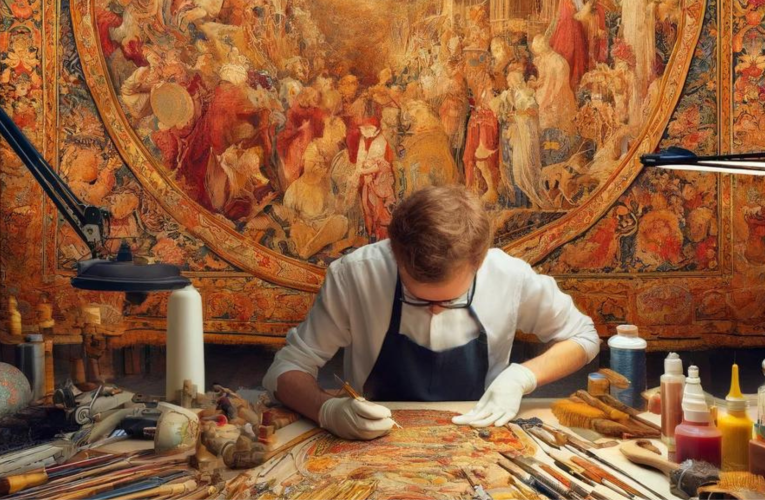
Documentation
Once the initial assessment is complete, the next step is to document the tapestry’s current condition meticulously. This involves taking high-resolution photographs from various angles, creating detailed written descriptions, and noting any specific areas of concern. This documentation serves multiple purposes. It provides a baseline against which the restoration’s progress can be measured, assists in the planning and execution of restoration strategies, and serves as a historical record. For future conservators and researchers, this documentation offers valuable insights into the tapestry’s condition at a specific point in time.
Research
Research is a foundational element of the Pre-Restoration Phase. It involves delving into the tapestry’s historical background, understanding its provenance, and studying the materials and techniques used in its creation. This step is crucial for several reasons. Firstly, it ensures that the restoration work is aligned with the tapestry’s historical and cultural significance. Secondly, it aids in selecting the most appropriate materials and methods for the restoration, aiming to match the original as closely as possible. Finally, research can uncover fascinating stories about the tapestry’s origins, its creators, and its journey through time, enriching the restoration process with context and meaning.
The Pre-Restoration Phase is a critical period that sets the stage for the intricate process of tapestry restoration. By thoroughly assessing the tapestry’s condition, documenting its current state, and conducting in-depth research, conservators ensure that each restoration project is approached with the care, precision, and respect these historical treasures deserve. This phase not only facilitates a successful restoration but also contributes to our understanding and appreciation of tapestries as significant cultural artifacts.
The Restoration Process
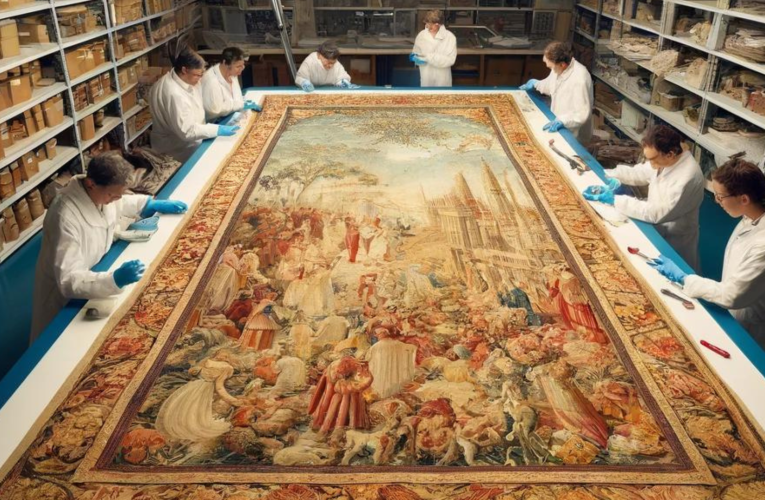
Tapestry restoration is a delicate art that breathes new life into historical and valuable textiles. These intricate pieces of art not only add aesthetic value to spaces but also carry historical significance, making their preservation paramount. This post delves into the nuanced process of tapestry restoration, highlighting the expertise and precision required at each step.
Cleaning
Methods for Cleaning Tapestries
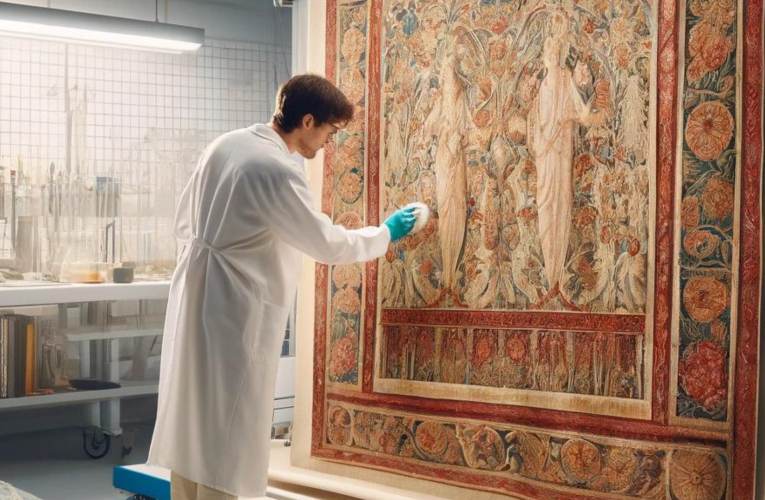
Cleaning is the first and crucial step in the restoration process. It involves a careful examination to understand the fabric’s type, age, and the extent of damage or soiling. Techniques vary from dry cleaning for sensitive fabrics to wet cleaning with mild detergents for more durable materials. The goal is to remove dirt and contaminants without compromising the tapestry’s integrity.
Challenges in Removing Stains
Stain removal poses significant challenges, especially when dealing with ancient or delicate fabrics. The risk of damaging the textile increases with the use of harsh chemicals. Restorers must balance efficacy with gentleness, often opting for custom solutions tailored to the specific type of stain and fabric, ensuring the tapestry’s longevity and beauty are preserved.
Repairing Physical Damage
Techniques for Repairing Holes and Tears
Physical damage, such as holes and tears, requires meticulous attention. Techniques include threading individual fibers back into place or employing a fine needle and thread to mend tears invisibly. The restorer’s skill in mimicking the original weaving technique is crucial for a seamless repair.
Re-weaving and Patching Methods
For more extensive damage, re-weaving or patching might be necessary. Re-weaving involves matching the tapestry’s original threads and weave patterns, requiring a deep understanding of historical weaving techniques. Patching is used when areas are too damaged for weaving, where a closely matched fabric is carefully stitched in place, maintaining the tapestry’s aesthetic coherence.
Color Restoration
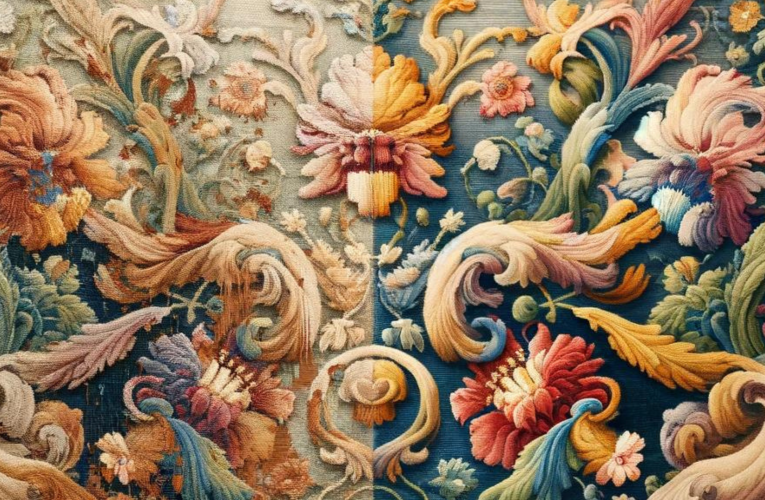
Approaches to Color Restoration
Color restoration is an art form in itself, involving the careful selection of dyes that match the original colors as closely as possible. This process requires a thorough understanding of how colors have faded or changed over time and how new dyes will interact with the tapestry’s existing fibers.
Dye Selection and Application Techniques
The choice between natural and synthetic dyes depends on the tapestry’s age, fabric type, and the desired longevity of the restoration. Application techniques must be precise, ensuring even coverage and color matching that blends seamlessly with the original hues, reviving the tapestry’s vibrancy while respecting its historical authenticity.
Tapestry restoration is a meticulous process that demands a high level of expertise and care. From cleaning to repairing physical damage and restoring colors, each step is critical in preserving the tapestry’s integrity and beauty. This delicate balance of art and science ensures that these historical textiles continue to tell their stories for generations to come, highlighting the invaluable role of professional restorers in cultural heritage preservation.
Post-Restoration Care
The restoration of tapestries is a meticulous process that breathes new life into these historical artifacts, preserving their beauty and historical value for future generations. However, the journey doesn’t end with the restoration itself. Post-restoration care is crucial to ensure that tapestries remain in their rejuvenated state for as long as possible. This section of the blog will delve into the essential steps for displaying and storing tapestries post-restoration and the critical role of environmental control in tapestry preservation.
Recommendations for Displaying and Storing Tapestries to Prevent Future Damage
After the delicate process of tapestry restoration, it’s imperative to consider how these artworks are displayed and stored to prevent future damage. Here are some key recommendations:
- Avoid Direct Sunlight: Direct exposure to sunlight can cause fading and deterioration of fabric fibers. Tapestries should be displayed in well-lit rooms but away from direct sunlight. Using UV-filtering glass or acrylic in windows and cases can provide additional protection.
- Proper Mounting: Tapestries should be properly mounted to distribute their weight evenly. Using a velcro mounting system is often recommended, as it allows the tapestry to hang smoothly and reduces stress on any single point of the fabric.
- Climate Control: Maintaining a stable environment with controlled temperature and humidity levels is crucial. Fluctuations can lead to expansion and contraction of the fabric, potentially causing damage over time.
- Avoid Chemical Exposure: Tapestries should be kept in areas free from pollutants and chemicals, including smoke, which can cause discoloration and degradation of fibers.
Regular Inspection and Cleaning: Regularly inspect tapestries for signs of wear or damage. Cleaning should only be done by professionals familiar with the specific needs of tapestry fabrics to avoid unintentional damage.
The Role of Environmental Control in Tapestry Preservation
Environmental control plays a pivotal role in the long-term preservation of tapestries. Here’s how:
- Temperature and Humidity: The ideal environment for tapestries is one where the temperature is consistently maintained between 18°C to 22°C (64°F to 72°F), with relative humidity at 50-60%. These conditions help prevent the growth of mold and mildew, which can degrade fabric fibers.
- Air Quality: Good air quality is essential to prevent the accumulation of dust and pollutants on the tapestry. High-efficiency particulate air (HEPA) filters can be used to reduce the presence of these harmful particles in the air.
- Light Control: Excessive light, especially ultraviolet (UV) light, can fade colors and weaken fibers. Using blinds, curtains, or UV-filtering glass can mitigate these effects. LED lighting is preferred for illumination as it emits minimal UV radiation.
The completion of tapestry restoration marks the beginning of a continuous commitment to its care and preservation. By implementing thoughtful displaying and storing practices and maintaining strict environmental controls, we can safeguard these precious artifacts. Not only does this allow current generations to enjoy the beauty and historical significance of tapestries, but it also ensures their survival for those yet to come.
This detailed approach to post-restoration care, focusing on both storage/display recommendations and environmental control, underscores the importance of a comprehensive preservation strategy for these valuable cultural treasures.
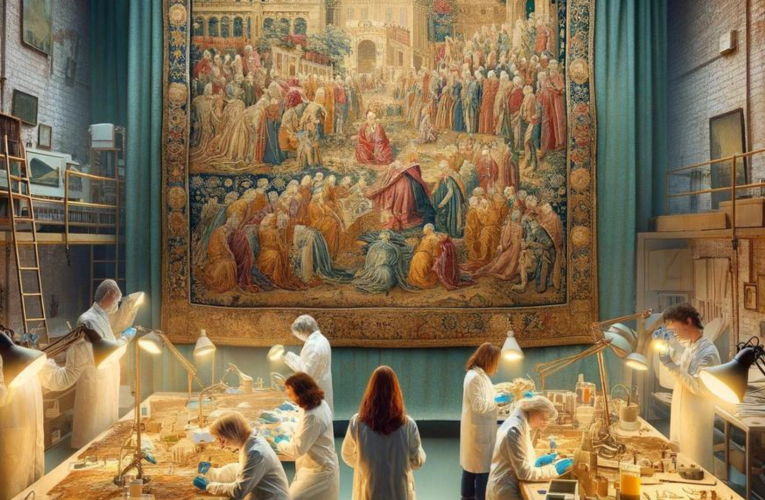
Challenges in Tapestry Restoration
Ethical Considerations: Balancing Historical Integrity with Restoration Needs
Ethical Considerations
Tapestry restoration sits at the crossroads of art preservation and historical fidelity. Ethical considerations emerge as restorers face decisions that could alter the tapestry’s narrative. This segment explores the delicate balance between maintaining a tapestry’s historical integrity and undertaking necessary restorations to preserve these artworks for the future.
The Debate on Restoration vs. Preservation
The conservation community is often divided on how much restoration is too much. On one hand, there’s a push to retain as much of the original fabric and design as possible, to preserve historical authenticity. On the other, some level of restoration is necessary to prevent further degradation. Guidelines from bodies like ICOM-CC (International Council of Museums – Committee for Conservation) help navigate these waters, but each tapestry presents a unique ethical puzzle.
Case Studies and Guidelines
Examples abound where ethical considerations have guided restoration decisions. The restoration of the 16th-century Devonshire Hunting Tapestries involved minimal intervention, adhering to the principle of ‘do no harm,’ showcasing a preference for preservation over restoration. Such cases highlight the ethical frameworks that guide conservators, ensuring decisions benefit the tapestry’s long-term integrity and historical value.
Technical Challenges: Matching Original Materials and Techniques
Restoring a tapestry involves more than just repairing tears or fading colors; it’s about recapturing the essence of the original creation. This includes matching the exact materials and techniques used by the original weavers, a task that often proves to be a significant hurdle due to the rarity and uniqueness of historical production methods.
Material Scarcity and Technique Replication
Many of the materials used in antique tapestries, such as specific dye plants or animal fibers, are no longer readily available, or the methods for their preparation have been lost to time. Similarly, weaving techniques that were once commonplace have become specialized knowledge. Restorers often have to become detectives, piecing together historical practices through research and experimentation.
Innovative Solutions and Technologies
Advancements in technology and science have opened new doors for tapestry restoration. For instance, digital analysis and 3D printing can replicate missing or damaged portions of tapestries with high accuracy. Dye analysis through chromatography allows for precise color matching, ensuring that restorations maintain the aesthetic integrity of the original work.
The Importance of Expert Knowledge and Skill in Tapestry Restoration
The Role of Expertise in Restoration
The successful restoration of a tapestry is a testament to the skill and knowledge of the conservator. Experts in tapestry restoration combine a deep understanding of art history, chemistry, and textile arts to navigate the complex restoration process, making decisions that respect the tapestry’s historical significance and physical integrity.
Training and Education
Professionals in this field often pursue specialized education in textile conservation, combining hands-on training with academic study. Institutions like the Courtauld Institute of Art in London offer programs that blend the study of historical techniques with modern conservation science, preparing conservators to meet the challenges of tapestry restoration head-on.
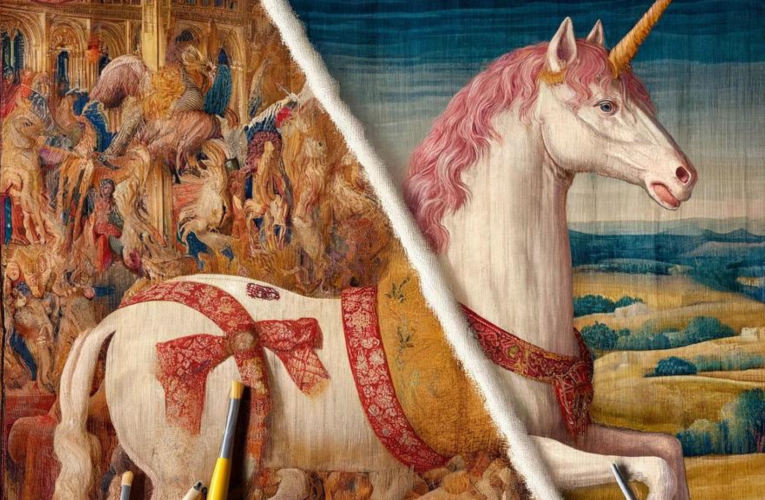
Case Examples of Successful Restorations
The restoration of the “Unicorn Tapestries” at the Metropolitan Museum of Art exemplifies the impact of expert restoration. Through meticulous work, conservators were able to reverse centuries of damage, revealing the vibrant colors and intricate details that had been obscured over time. Such successes underscore the transformative potential of skilled restoration work.
Tapestry restoration embodies a unique intersection of art, history, and science. The challenges in this field—from ethical considerations to technical hurdles—demand a nuanced approach, guided by expertise and respect for the past. As we navigate these challenges, the goal remains clear: to preserve the beauty and history of tapestries for future generations to appreciate and learn from.
FAQs Section
Tapestry restoration is a specialized process that involves cleaning, repairing, and sometimes restoring the color and fabric of tapestries that have been damaged or aged over time. It requires a deep understanding of textile conservation techniques and the historical context of the tapestry.
The cost of tapestry restoration can vary widely depending on several factors, including the size of the tapestry, the extent of the damage, the materials needed for repairs, and the tapestry’s age and historical value. Restoration can range from a few hundred to several thousand dollars. It’s best to consult with a restoration expert for a more accurate estimate based on a detailed examination of your tapestry.
The timeframe for tapestry restoration can vary from a few weeks to several months, depending on the complexity of the restoration needed, the tapestry’s size, and the conservator’s workload. Simple repairs may be completed relatively quickly, while extensive restorations, especially those involving color restoration or intricate repairs, will take longer.
Finding a reputable restoration expert involves a few steps:
- Research: Look for professionals who specialize in textile or tapestry restoration. Online searches, museum recommendations, and professional conservation organizations can be good starting points.
- Credentials: Check their credentials, including education, experience, and membership in professional organizations like the American Institute for Conservation (AIC).
- References and Portfolio: Ask for references and examples of previous work to assess their expertise and the quality of their restorations.
- Consultation: Schedule a consultation to discuss your tapestry and get a sense of the conservator’s approach and philosophy towards restoration.
Most tapestries can be restored, but the feasibility and extent of restoration depend on the tapestry’s condition, material composition, and the type of damage it has sustained. Some tapestries may only need minimal intervention, such as cleaning and stabilization, while others might require extensive repairs. A professional conservator can assess whether a tapestry can be successfully restored and to what extent.
Whether tapestry restoration is worth the investment depends on the tapestry’s sentimental, historical, and monetary value. Restoration can significantly enhance a tapestry’s appearance, preserve it for future generations, and, in some cases, increase its value. If the tapestry holds significant importance to you or has notable historical value, restoration is often considered a worthwhile investment.
To protect your tapestry after restoration:
- Avoid Direct Sunlight: Keep it out of direct sunlight to prevent fading.
- Proper Display: Ensure it’s displayed in a way that minimizes stress on the fabric.
- Climate Control: Keep it in an environment with stable temperature and humidity levels.
- Regular Dusting: Gently dust the tapestry regularly to prevent dirt accumulation.
- Professional Check-ups: Have it periodically examined by a professional to address any emerging issues promptly.


